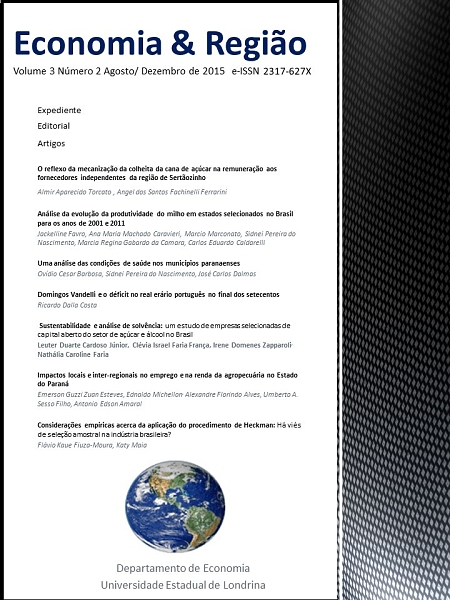Empirical aspects about Heckman Procedure Application: Is there sample selection bias in the Brazilian Industry
DOI:
https://doi.org/10.5433/2317-627X.2015v3n2p131Keywords:
Sample selection bias, Heckman's procedure, Labor market, Wage determination structure, Manufacturing industryAbstract
There are several labor market researches whose main goal is to analyze the probability of employment and the structure of wage determination and, for empirical purposes, most of these researches deploy Heckman sample selection bias hazard detection and correction procedure. However, few Brazilian studies are focused in this procedure applicability, especially concerning specific industries. This paper aims to approach these issues by testing the existence of sample selection bias in Brazilian manufacturing industry, and to analyze the impact of the bias correction procedure over the estimated coefficients of OLS Mincer equations. We found sample selection bias hazard only in manufacturing segments which average wages are lower than market average and only in groups of workers which average wage level is below the market average (women, especially blacks). The analysis and comparison of Mincer equations with and without Heckman's sample selection bias correction procedure brought up that the estimation's coefficients related to wage differential for male over female workers and the wage differential for urban over non-urban workers tends to be overestimated in cases which the sample selection bias isn't corrected.Downloads
References
BATISTA, N. F.; CACCIAMALI, M. C. Diferencial de salários entre homens e mulheres segundo a condição de migração. Revista brasileira de estudos populacionais, Rio de Janeiro, v. 26, n. 1, p. 97-115, jan/jun 2009.
BECKER, G. S. Human Capital and the Personal Distribution of Income. Woytinsky Lecture, Ann Arbor, n. 1, 1967.
BECKER, G. S. Human Capital: A Theoretical and Empirical Analysis with Special Reference to Education, New York: National Bureau of Economic Research. 1964.
BECKER, G. S. Investment in Human Capital: A Theoretical Analysis. Journal of Political Economy, v. 70, n. 5, Part 2, p. 9-49. 1962.
BECKER, G. S. The Economics of Discrimination. 2nd ed. Chicago: The University of Chicago Press, 1971.
BECKER, G. S.; CHISWICK, B. R. Education and the Distribution of Earnings. American Economic Review, v. 56, n. 2, p. 358-369. 1966.
CACCIAMALI, M. C.; TATEI, F.; ROSALINO, J. W. Estreitamento dos diferenciais de salários e aumento do grau de discriminação: limitações da mensuração padrão? Planejamento e políticas públicas, n. 33, jul./dez. 2009.
CHISWICK, B. R. Jacob Mincer, Experience and the Distribuition of Earnings. Chicago, Illinois: University of Illinois and IZA, Aug. 2003. (Discussion Paper n. 847).
CUGINI, S. C. B.; MAIA, K.; LOPES, R. L.; DEVIDÉ, A. J.; SOUZA, S. C. I. A força de trabalho feminina no mercado de trabalho brasileiro: Discriminação salarial por gênero em 2002 e 2011. In: ENCONTRO DE ECONOMIA PARANAENSE, 11., 2014, Apucarana, Anais... Apucarana: UNESPAR, 2014.
FIUZA-MOURA, F. K. Diferenciais de salário na indústria brasileira por sexo, cor e intensidade tecnológica. 96 f. Dissertação (Mestrado em Economia Regional) - Programa de Pós-Graduação em Economia, Universidade Estadual de Londrina, Londrina. 2015.
Sample selection bias as a specification error. National Bureau of Economic Research, California, 1977. (Working Paper n. 172).
HECKMAN, J. J. Sample selection bias as a specification error (with an application to the estimation of labour supply functions). Econometrica, n. 47, 1979.
HOFMANN, R.; SIMÃO, R. C. S. Determinantes do rendimento das pessoas ocupadas em Minas Gerais em 2000: o limiar no efeito escolaridade e as mesorregiões. Nova Economia, Belo Horizonte, v. 15, n. 2, maio/ago. 2005.
INSTITUTO BRASILEIRO DE GEOGRAFIA E ESTATÍSTICA. Pesquisa Nacional por Amostra de Domicílios. Rio de Janeiro: 2007. v. 28.
LIMA, R. Mercado de trabalho: o capital humano e a teoria da segmentação. Pesquisa e Planejamento Econômico, Rio de Janeiro, v. 10, abr. 1980.
MAIA, K.; LIRA, S. A. A mulher no mercado de trabalho. In: SEMINÁRIO DE ECONOMIA APLICADA, 2., 2002, Brasília. Anais... Brasília: UnB/IPEA/MTE, 2002.
MARCELO, R.; WYLLIE, R. Retornos para educação no Brasil: evidências empíricas adicionais. Economia Aplicada, Ribeirão Preto, v. 10, n. 3, p. 349-365, set. 2006.
MARGONATO, R. C. G.; SOUZA, S. C. I.; NASCIMENTO, S. P. Diferenciais de rendimentos do trabalho feminino no Sul do Brasil: uma abordagem dual. Economia & Região, v.2, n.1, p.90-107, 2014.
MINCER, J. Investment in human capital and personal income distribution. Journal of Political Economy, p. 66 - 281, 1958.
MINCER, J. On-the-Job Training: Costs, Returns and Some Implications. Journal of Political Economy, v. 70, p. 5, Part 2, S50-S79, 1962.
MINCER, J. Schooling, Experience and Earnings. New York: National Bureau of Economic Research.1974.
MOURA, R. L. Testando as Hipóteses do Modelo de Mincer para o Brasil. Revista Brasileira de Economia, Rio de Janeiro, v. 62, n. 4, p. 407-449, out./dez. 2008.
RAMOS, L. A desigualdade de rendimentos do trabalho no período pós-Real: o papel da escolaridade e do desemprego. Economia Aplicada, Ribeirão Preto, v. 11, n. 2, jun. 2007.
SACHSIDA, A.; LOUREIRO, P. R. A.; MENDONCA, M. J. C. Um estudo sobre retorno em escolaridade no Brasil. Revista Brasileira de Economia, Rio de Janeiro, v.58, n.2, p. 249-265, jun. 2004.
SENNA, J. J. Escolaridade, experiência no trabalho e salários no Brasil. Revista Brasileira de Economia, v. 30, n. 2, p. 163-193, 1976.
SCHULTZ, T. Investment in human capital. The American Economic Review, v. 51, n. 1, Mar.1961.
Downloads
Published
How to Cite
Issue
Section
License
Copyright (c) 2015 Economia & Região

This work is licensed under a Creative Commons Attribution 4.0 International License.
Economia & Região adota a Licença Creative Commons Attribution CC-BY 4.0 International, portanto, os direitos autorais relativos aos artigos publicados são do(s) autor(es), que cedem à Revista Economia & Região o direito de exclusividade de primeira publicação.
Sob essa licença é possível: Compartilhar - copiar e redistribuir o material em qualquer suporte ou formato. Adaptar - remixar, transformar, e criar a partir do material, atribuindo o devido crédito e prover um link para a licença e indicar se mudanças foram feitas.




















